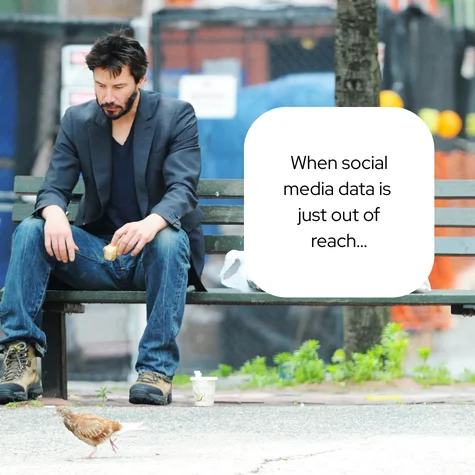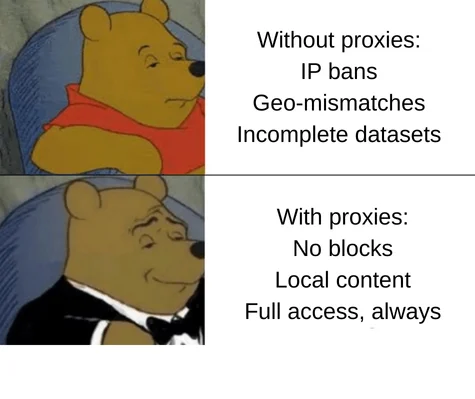
In this Article
Marketing is becoming increasingly reliant on immediate analysis from social platforms. For example, influencer research involves scraping Instagram profiles to gauge engagement levels, follower growth, and content trends. You might analyze dozens of accounts daily to evaluate reach, engagement ratios, follower growth, or sponsored content frequency. That means you need to scrape content across different locations. Without the right setup, you’ll either get blocked halfway or pull incomplete data that can lead to bad decisions.
After reading this, you’ll discover what’s in the essential stack and how it can transform fragile scrapers into reliable data machines.
How social media data is collected today
Social media data doesn’t just magically appear in marketing dashboards. Most teams rely on automated tools and custom scripts that extract public-facing data like comments, hashtags, follower counts, or mentions. Whether you’re pulling from Twitter, Reddit, Instagram, or TikTok, scraping is how marketers unlock the massive volume of raw insights hidden in plain sight. The goal? Turn this chaotic flow into something structured.
A marketer can scrape hundreds of tweets or Reddit threads about their brand or product launch, then run that text through a classifier to detect whether people are loving it or tearing it apart. But if the data is partial—say, missing regional posts, filtered too narrowly, or blocked after a few requests—the sentiment snapshot becomes skewed. On the surface, your campaign feels like a win, but the reality might be a different story in other corners.
That’s why accuracy matters. Marketing specialists must have clean, complete datasets. Their success depends on it. But collecting quality data isn’t easy. Between rate limits, IP bans, and geo-restricted content, gathering the full picture is a technical challenge. We’ll show you that the real fix lies in using the proper toolkit.
It’s not just Click and Collect
At first glance, scraping social media sounds like a straightforward task: just grab a tool and let it do the work. But under the hood, it’s a maze of roadblocks. Platforms like Instagram, TikTok, and X (formerly Twitter) are designed to resist automated access. Frequent IP bans, geo-restrictions, captcha walls, dynamic content loading, and rate limits make even basic data collection a struggle.
Imagine you’re tracking competitors across multiple platforms. You want to analyze their audience interactions, post frequency, and how they respond to feedback. But some platforms detect scraping patterns instantly, especially when requests come from the same IP. Others load content dynamically, meaning scrapers have to mimic real users just to access the data.
These layers of defense aren’t just technical annoyances, they directly impact the quality and reliability of the insights you collect.
Tools to solve the scraping puzzle
Many platforms are constantly shifting their policies and making it harder to access the data. That’s why every specialist needs a smart, up-to-date tech stack, built with reliable scrapers, headless browsers, and tools that can deal with dynamic content, hidden elements, and tough anti-bot defenses.
Let’s start with the basics. Free and open-source Python frameworks like Scrapy or cloud platforms like Apify make it easy to build flexible, scalable scraping setups. Whether you’re tracking TikTok hashtags or grabbing engagement stats from Instagram, these tools can help you out.
For marketers who’d rather skip the code, visual platforms like Octoparse and ParseHub offer user-friendly, drag-and-drop interfaces. They’re a great choice for quick, campaign-specific data tasks that need to be done in the short term.
But scrapers alone aren’t enough. When social platforms load content dynamically or require logins, you need browser automation like Playwright, Selenium, or Puppeteer to simulate real user behavior. These tools are essential for pulling full posts, engagement stats, or content hidden behind scrolling features.
Another step is integrating a captcha solver like CapSolver. With this helper, your setup can handle even the most restrictive scraping environments. And of course, just as important are proxies. Residential and mobile proxies will keep your IPs rotating and help you stay undetected.
As a quick recap, here are the main components of a reliable scraping stack:
- Scrapers – Platforms like Scrapy, Apify, or Octoparse for structured, scalable data collection;
- Browser automation – Tools like Playwright, Selenium, or Puppeteer to handle dynamic content and simulate user behavior;
- Captcha solvers – Services like CapSolver to avoid access restrictions;
- Proxies – Residential or mobile proxies to rotate IPs and stay undetected.
Make sure you have all the boxes checked.
Work on cleaner data with proxies
Why proxies? For the freedom to collect and the trust to act. They professionally manage requests using a pool of rotating IPs, meaning high data availability and integrity. The outcome is a reliable system for gathering data without downtime.
But what type of proxies is the best for social scraping? For people who work in marketing, it’s important to collect data without any barriers and to access content from different locations. In this case, proxies must offer stability, anonymity, and high success rates. These are exactly the strengths of residential proxies. At DataImpulse, you can try them for just $1 per 1 GB with no traffic expiry. Since the traffic never expires, it’s a smart, low-risk way to test and see what works.
Conclusion
In short, successful social scraping isn’t about luck, it’s about building the right system. Whether you’re tracking trends or chasing leads, quality data is a must. You need accurate, reliable data to actually make moves that matter. And proxies as a tool can help with upcoming challenges.
Want to give it a go? Hit the “Try now” button or drop us an email at [email protected]. We’ll help you get started right away.


